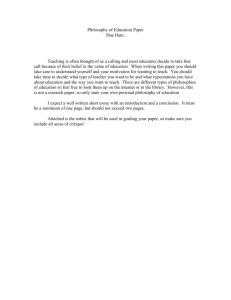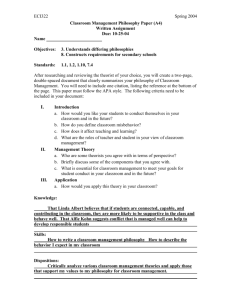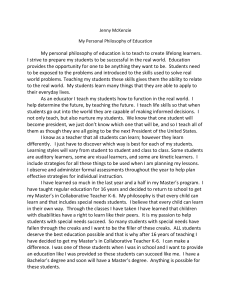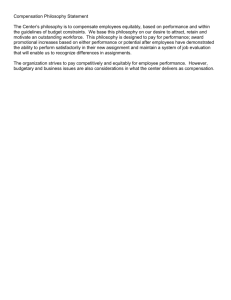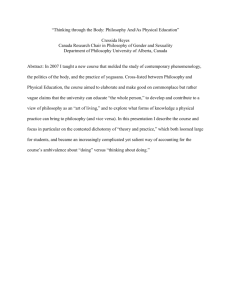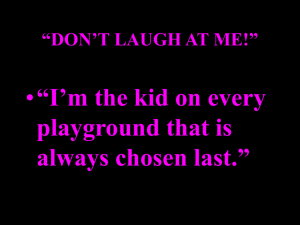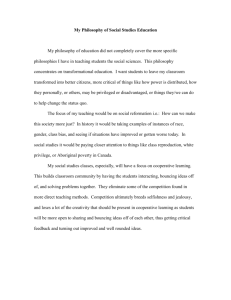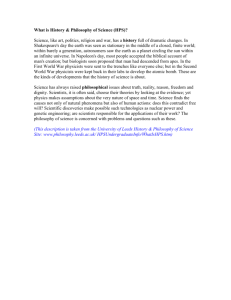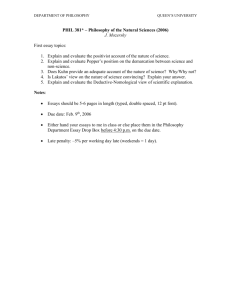Educational Philospohy
advertisement
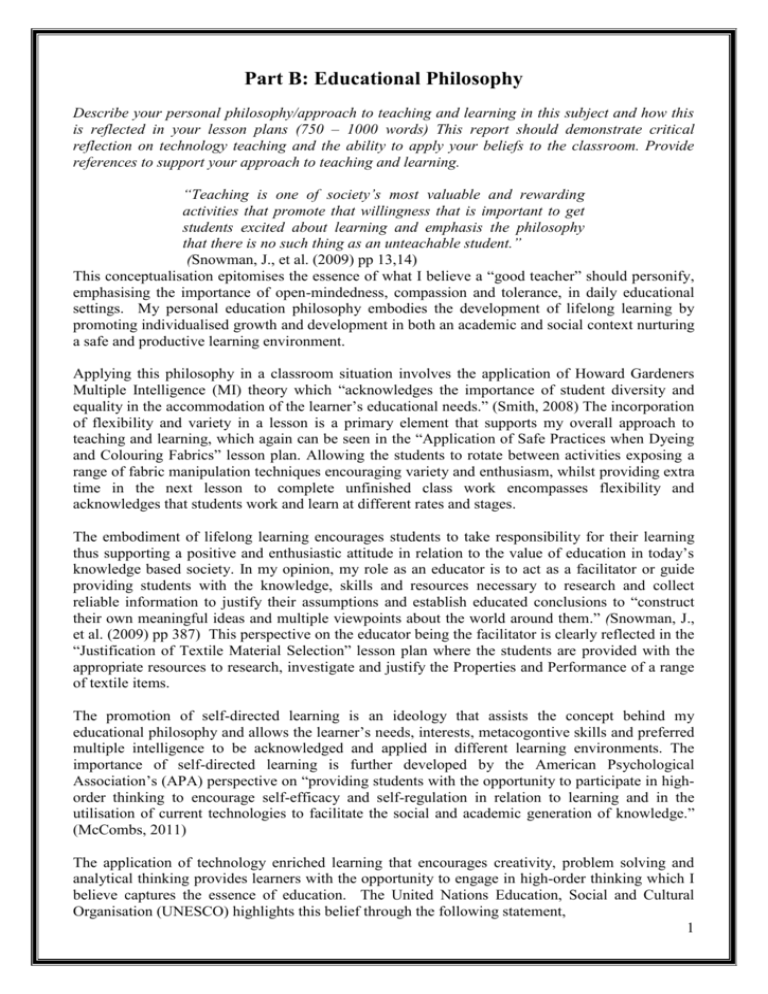
Part B: Educational Philosophy Describe your personal philosophy/approach to teaching and learning in this subject and how this is reflected in your lesson plans (750 – 1000 words) This report should demonstrate critical reflection on technology teaching and the ability to apply your beliefs to the classroom. Provide references to support your approach to teaching and learning. “Teaching is one of society’s most valuable and rewarding activities that promote that willingness that is important to get students excited about learning and emphasis the philosophy that there is no such thing as an unteachable student.” (Snowman, J., et al. (2009) pp 13,14) This conceptualisation epitomises the essence of what I believe a “good teacher” should personify, emphasising the importance of open-mindedness, compassion and tolerance, in daily educational settings. My personal education philosophy embodies the development of lifelong learning by promoting individualised growth and development in both an academic and social context nurturing a safe and productive learning environment. Applying this philosophy in a classroom situation involves the application of Howard Gardeners Multiple Intelligence (MI) theory which “acknowledges the importance of student diversity and equality in the accommodation of the learner’s educational needs.” (Smith, 2008) The incorporation of flexibility and variety in a lesson is a primary element that supports my overall approach to teaching and learning, which again can be seen in the “Application of Safe Practices when Dyeing and Colouring Fabrics” lesson plan. Allowing the students to rotate between activities exposing a range of fabric manipulation techniques encouraging variety and enthusiasm, whilst providing extra time in the next lesson to complete unfinished class work encompasses flexibility and acknowledges that students work and learn at different rates and stages. The embodiment of lifelong learning encourages students to take responsibility for their learning thus supporting a positive and enthusiastic attitude in relation to the value of education in today’s knowledge based society. In my opinion, my role as an educator is to act as a facilitator or guide providing students with the knowledge, skills and resources necessary to research and collect reliable information to justify their assumptions and establish educated conclusions to “construct their own meaningful ideas and multiple viewpoints about the world around them.” (Snowman, J., et al. (2009) pp 387) This perspective on the educator being the facilitator is clearly reflected in the “Justification of Textile Material Selection” lesson plan where the students are provided with the appropriate resources to research, investigate and justify the Properties and Performance of a range of textile items. The promotion of self-directed learning is an ideology that assists the concept behind my educational philosophy and allows the learner’s needs, interests, metacogontive skills and preferred multiple intelligence to be acknowledged and applied in different learning environments. The importance of self-directed learning is further developed by the American Psychological Association’s (APA) perspective on “providing students with the opportunity to participate in highorder thinking to encourage self-efficacy and self-regulation in relation to learning and in the utilisation of current technologies to facilitate the social and academic generation of knowledge.” (McCombs, 2011) The application of technology enriched learning that encourages creativity, problem solving and analytical thinking provides learners with the opportunity to engage in high-order thinking which I believe captures the essence of education. The United Nations Education, Social and Cultural Organisation (UNESCO) highlights this belief through the following statement, 1 “ know-how and creative processes that may assist people to utilise tools, resources and systems to solve problems and to enhance control over the natural and made environment in an endeavour to improve the human condition.” (1985) Based on critical reflection, I consider that technology education provides students with practical knowledge that can be realistically applied outside the school environment, for example, employment situations. Problem solving and critical thinking and justification support experimentation and challenge students to think creatively applying the appropriate design materials, information and systems which are employed in education environments. Co-operative Learning and Communication of Ideas, in relation to a brief, are two prime examples of learning experiences featured in my lesson plans that can be utilised and valued outside the school environment. “If you’re not prepared to be wrong, you’ll never come up with anything original.” (Robinson, 2007) This ideology by “International Advisor on Education in the Arts” Ken Robinson appreciates the significance of allowing students to express and develop their creative and design abilities in subjects featured in the Technology and Applied Science Department (TAS) department including, for example, Textile, Food, Wood and Metal Technologies. My education philosophy acknowledges the value and effectiveness of technology education in today’s schools, highlighting my passion to promote TAS subjects as equal academic contenders with the traditional and more conventional subjects such as Maths and English. The optimisation of Information Communication Technologies (ICT) in an educational context is another aspect that I consider necessary to apply in classroom circumstances, especially in the area of technology education. The “increasing growth and ubiquity of ICT are redefining the boundaries and possibilities of learning capabilities and achievements, however due to the book focussed culture considerable investments in mulit-media resources have not yet revolutionised students learning.” ((The nature of Learning, (2010) pp16) and (Bahr, & Pendergast, (2007) pp 23)) The following statistics reinforce this viewpoint and explains the increasing importance of ICT in contemporary learning environments, “About nine out of ten technology education programs employ computer based instructional activities. On average forty-one percent used a computer as a tool to complete an activity or solve a problem.” (Sanders, (2001) pp 12) I believe when utilised correctly, ICT can engage learners more effectively in contemporary learning environments than conventional means, intrinsically inspiring students to become enthusiastic towards learning thus facilitating the circumstances that produce innovative and creative work. This point of view explains why an ICT element needs to be incorporated into at least one lesson plan, for example, the “Photoshop Lesson” asked learners to “utilse suitable technology to innovatively document, communicate and facilitate design and project base work.” (Board of studies NSW 2003) The principles that conceptualise my educational philosophy personify the significance of forming positive teacher-student relationships accompanied by providing positive reinforcement, constructive feedback and setting realistic educational goals. My educational philosophy personifies the above teaching qualities and is evidentially reflected in the structure of my Lesson Plans. Promoting lifelong learning and the value of technology education, is a vital element that influence 2 a student’s development and learning capabilities. I acknowledge that applying this ideology to the learning environments will, “Recognise the learner as its core participant, encouraging their active engagement and develops in them an understanding of their own activity as learners. This means developing the meta- cognitive skills for learners to monitor, evaluate and optimise their acquisition and use of knowledge. It means to be able to regulate one’s emotions and motivations during the learning process.” (The nature of Learning, (2010) pp15) 3 Reference List Bahr, N., & Pendergast, D. (2007). The Millennial Adolescent. (pp 23). Victoria: ACER Press Australian Council for Educational Research LTD. McCombs, B. (2011). Developing Responsible and Autonomous Learners: A key to motivating students. Retrieved March 28th 2011 from http://www.apa.org/education/k12/learners.aspx Sanders, M. (2001). New Paradign or Old Wine? The status of Technology Education Practice in the United States.(pp 12). Journal of Technology Education, 12(2), Retrieved March 28th 2011 from file:///Users/arna/Desktop/ACU/Readings/JTE%20Volume%2012,%20Issue%202.webarchive Smith, M,K. (2008). Howard Gardner, Multiple Intelligences and Education . Retrieved March 28th 2011 from http://www.infed.org/thinkers/gardner.htm Snowman, J., Dobozy, Scevak, Bryer, Bartlett, Biehler (2009). Psychology Applied to Teaching. (pp 13, 14, 387). Milton, Queensland: John Wiley & Sons Australia. Robinson, K. (2007, December 16). Your Creative Kick in the Butt. Retrieved March 27th from http://judithjaeger.blogspot.com/2007/12/if-youre-not-prepared-to-be-wrong-youll.html Board of studies NSW (2003) Textiles Technology years 7-10. Syllabus. Sydney BOS. The Nature of Learning. (2010). [pp.15,16 ]. (DX reader version), Retrieved March 27th 2011 from http://blackboard.acu.edu.au/webct/cobaltMainFrame.dowebct What is Technology Education. (1999). Retrieved March 27th 2011 from http://www.pa.ash.org.au/tefa/wite.html By Courtney Armstrong Student number: S00084491 Unit Code: EDST 447 Technology CT Assignment 2 Teaching Technology: Part B Educational Philosophy Lecturer: Dr Arna Wesley 4
